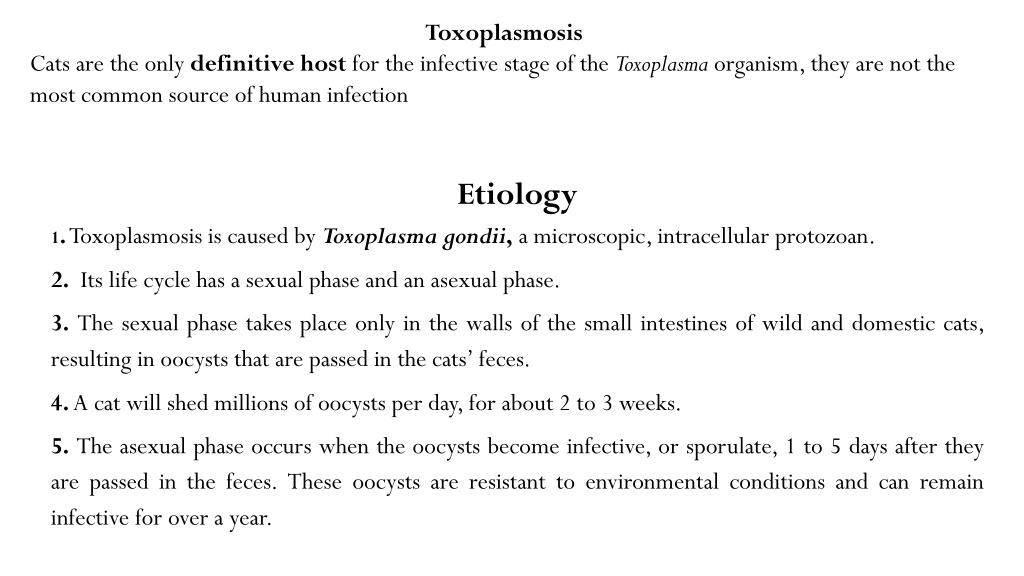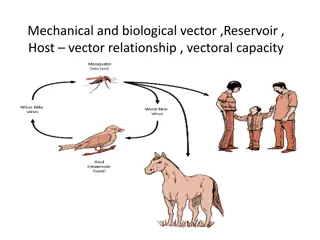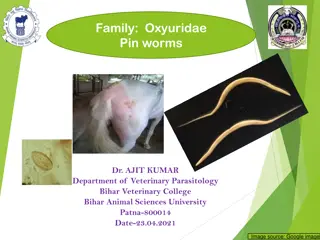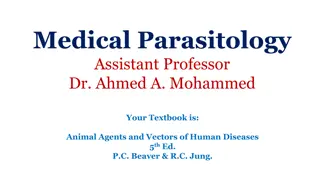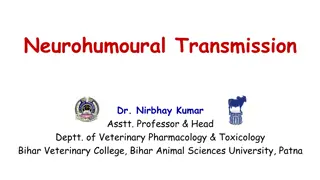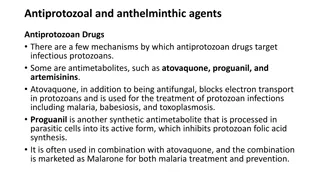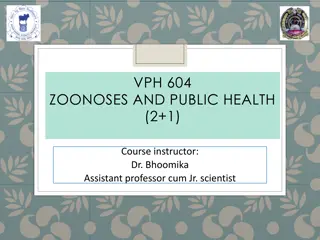Understanding Toxoplasmosis: Causes, Transmission, and Hosts
Toxoplasmosis is caused by the Toxoplasma gondii parasite, with cats being the definitive host. The parasite's life cycle involves both sexual and asexual phases, leading to potential infection in humans and other animals. Transmission can occur through contact with cat feces, ingestion of contaminated meat, or direct exposure to oocysts from infected cats. Awareness of transmission methods and prevention strategies is crucial for minimizing the risk of infection.
Download Presentation

Please find below an Image/Link to download the presentation.
The content on the website is provided AS IS for your information and personal use only. It may not be sold, licensed, or shared on other websites without obtaining consent from the author. Download presentation by click this link. If you encounter any issues during the download, it is possible that the publisher has removed the file from their server.
E N D
Presentation Transcript
Toxoplasmosis Cats are the only definitive host for the infective stage of the Toxoplasma organism, they are not the most common source of human infection Etiology 1. Toxoplasmosis is caused by Toxoplasma gondii, a microscopic, intracellular protozoan. 2. Its life cycle has a sexual phase and an asexual phase. 3. The sexual phase takes place only in the walls of the small intestines of wild and domestic cats, resulting in oocysts that are passed in the cats feces. 4. A cat will shed millions of oocysts per day, for about 2 to 3 weeks. 5. The asexual phase occurs when the oocysts become infective, or sporulate, 1 to 5 days after they are passed in the feces. These oocysts are resistant to environmental conditions and can remain infective for over a year.
6.When the sporulated oocysts are ingested by an animal, they go to the animals small intestine, enter the tachyzoite stage, penetrate the intestinal wall, and travel to other parts of the body in lymph and blood. During this rapidly multiply in the cytoplasm of monocytes and macrophages. stage, tachyzoites 7. The tachyzoite (asexual) stage, which is called the active or acute phase, lasts until the host s immune system produces some immunity about 2 weeks. 8. Once the immunity develops, the tachyzoites slow their multiplication rate and become bradyzoites, which accumulate in the cytoplasm of tissue cells and form cysts. 9. The cysts can be found anywhere in the body, but are most commonly seen in skeletal muscle, myocardium, and brain tissue. 10. The bradyzoite (asexual) stage is the inactive phase. 11. Cysts can remain in the host for the rest of its life. If the host s immunity is somehow suppressed, the bradyzoites can become rapidly multiplying tachyzoites again, resulting in a latent or chronic infection.
Hosts *Cats are the only definitive host for T. gondii. *Other animals, considered intermediate hosts. including people, that become infected with T. gondii are
Transmission Transmission from cats to animals occurs when animals come in contact with sporulated Toxoplasma oocysts. The oocysts can be found where cats defecate, such as moist soil. Cats also can become infected by coming in direct contact with the feces from other infected cats. Animals on pasture, such as sheep, pigs, goats, and cattle, can ingest the oocysts while they are grazing. Their meat (skeletal muscle) will then become infected with T.gondii cysts that can be transmitted to people or other carnivores and scavengers, including cats, that eat the meat raw or undercooked.
Rarely people can become infected directly from cats if they ingest or breathe in the sporulated oocysts from an infected cat,this can happen when hands become conta minated. Working in soil without gloves and playing in a sandbox are other methods of direct infection from cats. Infection can also occur after eating unwashed vegetables from gardens or after drinking contaminated water. Oocysts can be carried on the wind or in water to distant places. Transmission can also occur trans placentally in people if a mother is infected near the time she becomes pregnant or soon after. This results in congenital toxoplasmosis.
Toxoplasmosis in Animals Many species of animals and birds are susceptible to T. gondii infection, but clinical disease is rare. In sheep and goats, congenital toxoplasmosis can cause abortion and disease in newborn lambs. Dogs are commonly infected but rarely become ill. Many cats are infected with T. gondii as kittens or young adults. Most of them will be asymptomatic and immune to repeat infections as adults. Clinical toxoplasmosis is characterized primarily by pneumonia of increasing severity, other signs are nonspecific and include fever, depression, anorexia, and lethargy.
Toxoplasmosis in Humans Every year in the United States, 3000 babies are born with congenital toxoplasmosis. Unlike congenital toxoplasmosis, toxoplasmosis acquired after birth most often goes undetected or is characterized by mild, flu like or mononucleosis-like symptoms, including swollen lymph nodes in the head and neck, headache, sore throat, and muscle pain that lasts for a few days to a month or more. The incubation period is 1 to 2 weeks. In most cases the disease is self-limiting. because it is controlled by the immune system. Severe toxoplasmosis, however, can result in lesions in the eyes and central nervous system. Latent toxoplasmosis, brought on by immunosuppression, is characterized by central nervous system lesions that result in headache, confusion, seizures, and other neurological signs. Clinical congenital toxoplasmosis is characterized by central nervous system and ocular disorders. These disorders include mental retardation, hydrocephalus, convulsions, deafness, blindness, or cerebral palsy. Ocular toxoplasmosis is another consequence of congenital toxoplasmosis. It develops as chorioretinitis during a person s 20s and 30s.
Diagnosis Patient history. Clinical signs. Results of diagnostic tests. (Can lead to a presumptive diagnosis of toxoplasmosis) diagnostic testsinclude: Lymph node biopsy. Examination of respiratory fluid. Examination of the retina. Women who are pregnant or trying to conceive and who have had contact with cats may want to have serology testing to determine if has antibodies against T.gondii,If they do have the antibodies, it greatly reduces the chances of congenital toxoplasmosis developing in the fetus.
Prevention Exclude raw and undercooked meat from the diet.Cooking meat to an internal temperature of 158 F (70 C) for at least 15 minutes will kill the cyst Do not drink untreated water from streams, lakes, or rivers. Wash hands, cutting boards, and utensils in warm, soapy water after handling raw meat. Wear gloves when working in potentially infected soil in gardens and flower beds.
